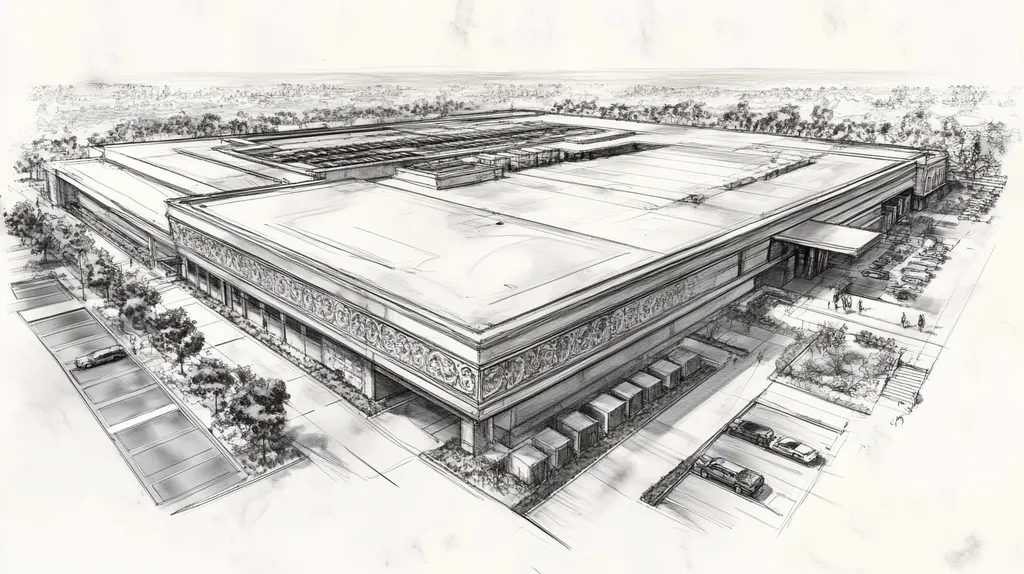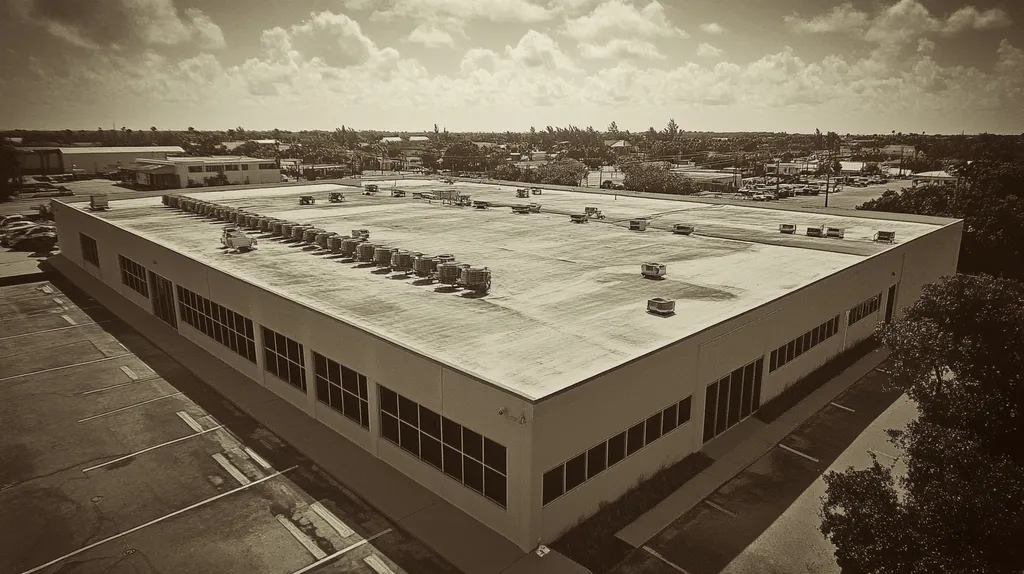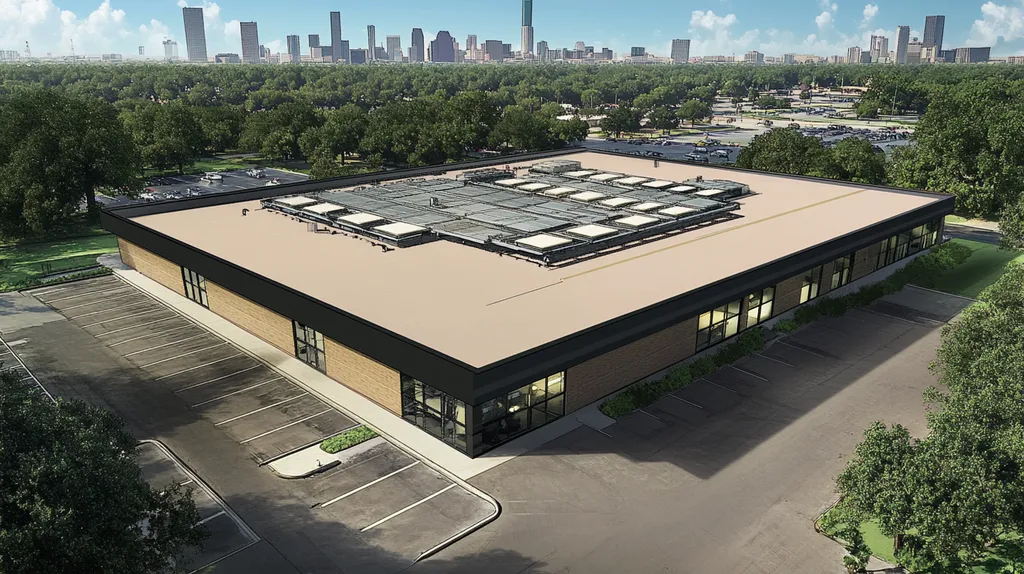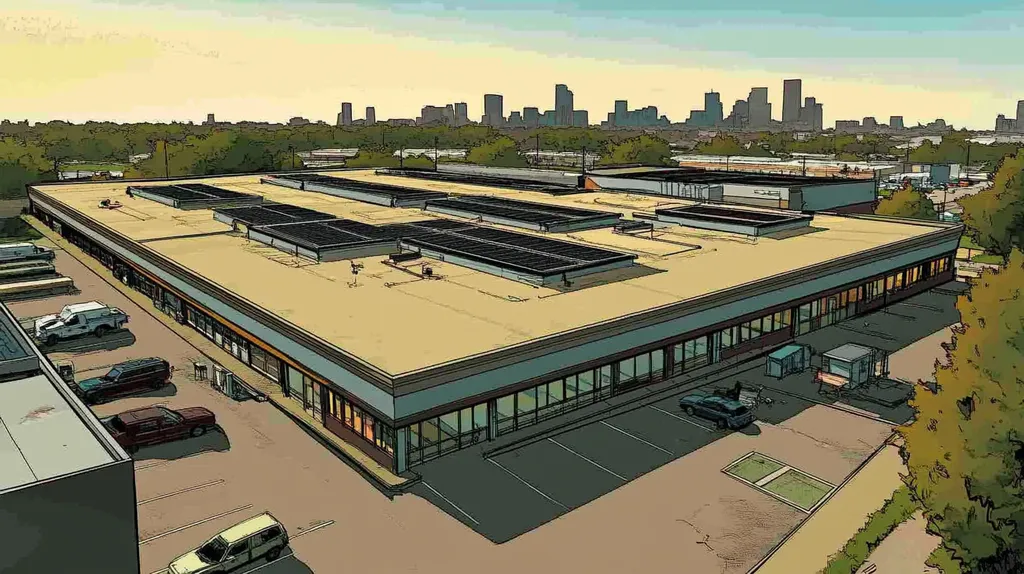Every winter, thousands of industrial roofs face catastrophic damage due to improper snow removal techniques and inadequate equipment. In fact, studies show that 70% of winter-related roof collapses could have been prevented with the right tools and knowledge.
From specialized snow rakes to heated removal systems, having the correct equipment isn’t just about efficiency – it’s about survival. Yet misconceptions about winter roof maintenance continue to put billions in property value at risk.
This comprehensive guide cuts through common myths about winter roofing equipment, providing facility managers with clear, actionable insights for protecting their industrial roofs during the harshest months.
SECTION 1: COMMON MISCONCEPTIONS
Winter brings unique challenges for industrial roofing, leading many property owners and facility managers to embrace misconceptions that could endanger safety and structural integrity. Each year, a shocking number of roofs fail under heavy snow loads, highlighting the importance of proper maintenance and specialized equipment. By addressing these common myths, decision-makers can better protect their assets and maintain safe operations throughout the winter months.
Myth: DIY Snow Removal is Safe
The idea that clearing snow from roofs is a simple DIY task is a widespread but dangerous misconception. Snow accumulation can create hidden hazards, such as icy layers or falling debris, which are not easily visible from the ground.
Heavy snow and ice can apply tremendous stress to roofs. Slips and falls are common, potentially resulting in significant medical expenses and legal liabilities.
Additionally, attempting to use improper techniques or tools can be more damaging than the snow itself. Damaging the roofing membrane can lead to leaks and other long-term structural problems.
For the utmost safety and effectiveness, hiring professionals equipped with the right snow removal tools is essential. This not only protects the roof but also reduces the chances of costly repairs down the line.
Misconception: All Roofs Can Handle Snow Guards
It’s a common belief that snow guards work effectively on any roof type, but this simply isn’t true. Different roofing materials and designs require tailored strategies.
For instance, a sloping metal roof may accommodate certain snow guards well, while flat roofs present distinct challenges. Factors like weight distribution and snow load can dramatically influence guard performance.
Moreover, improperly sized or installed snow guards can fail to stop snow from sliding off, creating unsafe conditions below. Each roof has specific needs that demand customized solutions.
By understanding the capabilities and limitations of snow guards, property owners can avoid costly errors and enhance safety during winter. Consulting roofing experts can illuminate the best options for each particular roof structure.
Belief: Standard Tools Are Sufficient for Winter Roof Work
Some property owners mistakenly believe that everyday landscaping tools or standard equipment will suffice for winter roof maintenance. This notion can be misleading and even risky. Specialized winter maintenance tools have been developed to address the unique challenges posed by cold conditions.
For example, heated tools can effectively prevent ice buildup, making snow removal easier without harming the roof’s surface. Standard tools like shovels or brooms simply can’t provide the care needed during severe winter weather.
Using unsuitable tools can lead to increased wear and tear on the roofing material, resulting in leaks and the need for premature roof replacements. Recognizing the distinct demands of winter roofing work underscores the necessity for proper equipment.
Investing in specialized tools and training ensures roofing professionals can effectively tackle the difficulties of winter weather while promoting longevity and safety in their operations.
SECTION 2: PRACTICAL IMPLICATIONS
As winter descends, industrial roofing faces formidable challenges that demand attention. Neglecting proper snow and ice management can lead to not just structural damage, but also costly repairs and safety incidents. In fact, a staggering 40% of commercial roofing failures stem from inadequate snow management practices. This section highlights the urgent need for proper winter care, shedding light on the risks of roof damage, the safety hazards for maintenance staff, and the overall impact on roof structures.
Roof Damage from Inadequate Snow Removal
When snow piles up on roofs, it can add thousands of pounds—weight that many structures are not designed to handle. This extra load can weaken roofing systems, causing premature wear or, in extreme cases, collapse. While manufacturers provide snow load limits, properties often overlook these vital guidelines, putting themselves at risk.
Consider a flat roof without proper drainage; it can accumulate water, creating ice dams that lead to damaging leaks. These leaks jeopardize insulation and can affect ceilings, resulting in expensive repairs and unnecessary downtime.
Regular inspections and prompt snow removal are not just best practices; they are essential for maintaining warranty coverage. Ignoring these responsibilities can void warranties, leaving property owners facing hefty repair bills.
Being proactive about snow management isn’t just a smart financial move; it’s a necessity for safeguarding property value and ensuring long-term structural integrity.
Safety Risks for Untrained Maintenance Staff
Winter’s icy conditions can create treacherous working environments, posing significant risks to untrained maintenance staff. Slips, falls, and serious injuries are all too common, leading to lost workdays and skyrocketing insurance premiums. In fact, slips and falls account for over 30% of worker injuries during the winter months.
Using improper equipment only adds to these safety hazards. For example, trying to clear snow with a ladder or traditional tools can turn risky, especially on industrial roofs lacking stable access points.
Employers have a legal obligation to maintain a safe workplace. Ignoring the safety of employees during winter maintenance can lead to liability issues and expensive legal consequences. Thus, investing in thorough training and specialized equipment is not only prudent but essential.
Implementing a winter safety protocol is a smart strategy that not only protects employees but also boosts overall productivity and mitigates the financial fallout from workplace injuries.
Impact of Ice and Snow on Roof Structures
The effects of ice and snow extend far beyond the roof’s surface; they can wreak havoc on the overall structural integrity. As snow melts and refreezes, it can form ice blocks that obstruct drainage systems, increasing water weight and enhancing the risk of leaks.
This cycle can deteriorate roofing materials faster than anticipated, shortening their lifespan. In severe cases, the building’s structural framework may suffer significant compromise, leading to complicated and costly repairs.
For industrial facilities housing critical equipment or inventory, the stakes are even higher. A roof failure could halt operations, causing serious financial losses and reputational damage.
Therefore, understanding the winter weather’s impact on roofing structures is critical. Investing in specialized snow and ice removal protocols is not just a precaution; it’s a proactive measure that ensures operational efficiency throughout the winter months.
SECTION 3: COST OF MISINFORMATION
Winter conditions pose serious challenges for industrial roofing. Misinformation about roof maintenance during this season can lead to devastating financial repercussions for property owners and facility managers. For example, a single roof collapse due to excess snow and ice can rack up costs in the hundreds of thousands of dollars. Grasping the true financial ramifications of neglecting proper winter techniques is essential for preserving both safety and profitability.
Financial Consequences of Roof Collapses
Failing to prepare for winter weather can result in significant financial fallout. A roof collapse doesn’t just damage the structure; it jeopardizes personnel safety and puts valuable inventory at risk. Repair costs can soar into six figures, and if employees are injured, legal claims can compound these expenses.
The fallout extends beyond immediate repairs. Business operations can be halted during investigations, leading to lost revenues that are hard to recover. Implementing proactive strategies—like investing in specialized winter roof equipment—can dramatically reduce the likelihood of such devastating incidents.
Furthermore, the costs associated with meeting regulatory requirements following a collapse can be considerable. Inspections, added safety measures, and compliance with updated codes can all contribute to the mounting financial burden of a preventable situation.
Thus, recognizing the importance of the right equipment and methods for winter roof work can protect financial resources in the long term.
Costs of Emergency Repairs and Shutdowns
Emergency repairs stemming from winter-related issues can wreak havoc on budgets and interfere with daily operations. Damage from snow or ice often necessitates immediate action, disrupting workflows and incurring unexpected costs that could derail even the most meticulously planned budgets.
For instance, when severe weather damages a roof, facility managers may face unanticipated bills for emergency services. These costs can encompass not only repairs but also expenses tied to relocating personnel and productivity losses.
Shutdowns necessitated by urgent roof repairs can further strain finances. Halting production translates to direct revenue loss—especially in industries where downtime equals significant financial setbacks. Therefore, investing in appropriate winter roofing equipment is more than just wise; it’s crucial for safeguarding the bottom line.
Long-Term Effects on Roof Lifespan
Believing misinformation surrounding winter roofing practices can also have detrimental effects on a roof’s long-term integrity. A roof that is poorly maintained and subjected to excessive winter loads will likely need replacement long before its expected lifespan. Each winter can worsen vulnerabilities, especially when proper equipment and techniques are neglected.
Ultimately, neglecting winter maintenance protocols leads to cumulative stress on roofing materials, increasing fatigue and weakening structural integrity over time. Roofs that endure repeated winter strain can deteriorate more quickly, resulting in higher costs down the line.
Moreover, the prospect of replacing a roof is daunting—it’s a significant expense that also disrupts daily operations. Therefore, consistent winter care not only helps extend the life of the roof but also protects the investment already made.
In summary, awareness of how misinformation can inflate overall costs is critical for property owners. Investing in specialized equipment and adhering to established best practices can stave off long-term damage, safeguard assets, and ensure better operational efficiency.
SECTION 4: REALITY CHECK
As winter approaches, the stakes for industrial roofing become even higher. An alarming 70% of winter roof incidents occur due to inadequate preparation and maintenance. Property owners and facility managers must understand that effective pre-winter inspections are not only helpful; they are vital for ensuring safety and cost efficiency. In this section, we’ll dive into the importance of pre-winter inspections, the value of professional roof maintenance plans, and the critical need for OSHA compliance during winter roof work.
Importance of Pre-Winter Roof Inspections
Pre-winter roof inspections are crucial for spotting vulnerabilities that may lead to serious problems when the weather turns nasty. Snow and ice can amplify existing issues like cracks or weakened seams, making early detection essential.
These inspections assess the roof’s overall integrity, ensuring that drainage systems are clear and identifying areas at high risk for leaks. Taking these proactive measures can nip small issues in the bud, preventing them from blossoming into costly repairs over time.
A thorough inspection can also inform decisions regarding necessary temporary or permanent repairs before the winter storms roll in. Roofing professionals often suggest scheduling these assessments in late fall for the best results.
By prioritizing pre-winter inspections, property owners can significantly mitigate liability issues and bolster their roofs’ ability to withstand winter conditions.
Role of Professional Roof Maintenance Plans
Implementing a professional roof maintenance plan is essential for any industrial property as winter approaches. Such a plan outlines regular inspections and maintenance tasks aimed at keeping roofs in prime condition throughout the year.
These maintenance plans typically include winterization steps, like clearing debris that can trap moisture and cause ice dams. Regular upkeep not only extends the roof’s life but also protects the property’s value and helps avoid unplanned shutdowns.
Plus, a well-defined maintenance strategy can drastically reduce emergency repair costs. Facilities that adopt proactive maintenance practices often enjoy a 30% decrease in emergency service calls during winter months.
Incorporating winter-specific measures into maintenance plans prepares roofs for seasonal challenges, enhancing safety and operational efficiency for employees and equipment alike.
Necessity of OSHA Compliance in Winter Roof Work
OSHA compliance is not just a regulatory checkbox; it’s a fundamental component of safety during winter roof work. As weather conditions become unpredictable, following OSHA guidelines ensures that safety protocols are in place to protect workers from falls and other hazards.
This compliance includes providing appropriate fall protection equipment and ensuring all employees receive proper training. Research indicates that workplaces strictly adhering to OSHA standards see significantly fewer incidents of injuries and fatalities.
Moreover, maintaining compliance bolsters a company’s reputation. Property owners who prioritize safety stand to enhance their standing in the industry while avoiding costly fines linked to non-compliance.
Ultimately, committing to OSHA standards not only safeguards employees but also helps prevent operational disruptions caused by accidents, ensuring a safer work environment amid winter challenges.
SECTION 5: EVIDENCE-BASED ALTERNATIVES
As winter’s chill seeps in, the threat of snow and ice accumulation on industrial roofs looms larger than ever. This weight can lead to serious structural damage, safety risks, and costly repairs. In fact, studies show that proper snow management can significantly enhance the lifespan of roofing systems. This section explores effective alternatives that include specialized equipment, rooftop additions, and best practices for safe snow management.
Benefits of Specialized Snow Removal Equipment
Specialized snow removal equipment plays a crucial role in minimizing roof damage during winter months. Tools such as snow rakes, heated mats, and snow blowers are specifically designed for rooftop use, effectively and safely tackling snow loads.
For instance, a snow blower can clear large flat roofs much faster than manual shoveling, saving both time and labor costs while allowing businesses to resume operations without long downtime.
Plus, these tools often come with features that ensure safety for roofing materials. Snow rakes with padded edges, for example, prevent scratches and dents while getting snow off roofs efficiently.
Investing in specialized equipment not only protects the structural integrity of the building, but it can also lead to significant financial benefits over the long haul.
Advantages of Snow Guards and Other Rooftop Additions
Incorporating snow guards and similar rooftop accessories can significantly lessen the risks associated with heavy snow accumulation. Designed to retain snow and ice, snow guards prevent sudden slides that could jeopardize the safety of individuals and property below.
These systems help evenly distribute the weight across the roof, reducing stress on vulnerable areas and minimizing the potential for structural damage. Without snow guards, roofs can be more susceptible to sagging or cracking under concentrated loads.
Additionally, the implementation of these devices might qualify properties for insurance discounts. Insurance providers often recognize the reduced risk associated with snow retention systems, making their installation not just a practical safety measure but also an economical one.
Ultimately, installing snow guards enhances safety and protects roofing investments, marking a smart choice for industrial facilities.
Best Practices for Safe and Effective Snow Removal
Establishing best practices for snow removal is essential for both efficiency and safety. Prior to winter, conducting regular inspections can help identify areas of concern and inform necessary modifications to improve snow management.
During the snow removal process, workers should adopt a systematic approach, starting at the roof edges and moving towards the center. This method prevents unnecessary weight on weaker sections and enhances stability and safety.
Proper training for staff on techniques using specialized equipment is critical. It ensures that all team members are aware of the risks involved and know how to mitigate them. Rigorous adherence to safety protocols, including the use of personal protective equipment (PPE), is a must.
Moreover, creating a snow removal schedule aligned with weather forecasts can streamline operations. By anticipating snowfall, businesses can better prepare and protect their roofs from potential overload.
SECTION 6: TEST AND VERIFY
As winter draws near, verifying the integrity of an industrial roof becomes a top priority. Ignoring the need for thorough assessments can lead to severe structural issues, hefty repair costs, and safety risks for all involved. With statistics revealing the dangers of frozen water accumulation on roofs, it’s clear that proactive testing is essential. This section outlines critical steps for ensuring roof integrity, evaluating drainage systems, and maintaining compliance with safety standards to protect both property and personnel.
Verifying Roof Integrity Before Winter
Before the ice and snow arrive, confirming the roof’s integrity is key. This process should include inspecting for visible damages such as cracks, blisters, or loose materials. Utilizing moisture surveys can uncover hidden moisture issues that might otherwise go unnoticed.
Infrared thermography serves as a powerful tool for detecting trapped moisture beneath roofing membranes. Identifying these problems early can save significant time and resources when winter hits.
Furthermore, examining the condition of seams and flashings is crucial. Overlooked weak points can lead to water infiltration, causing more extensive damage during the winter months.
Engaging reputable roofing contractors for these essential evaluations is advisable. Their expertise ensures that any necessary pre-winter repairs are performed well ahead of the freeze.
Testing Drainage and Gutter Systems
A properly functioning drainage system is vital for maintaining industrial roofs during winter. Snow and ice build-up can quickly obstruct drainage pathways, leading to dangerous ponding water. Regular cleaning and maintenance of gutters and downspouts are essential for proper water flow.
However, testing the drainage system goes beyond mere visual inspections. Conducting flow tests assures that water navigates freely through the entire system, preventing winter-related issues like ice damming.
In addition to routine cleaning, reinforcing critical gutter components can provide added durability against winter strains. Facilities managers should maintain detailed records of drainage system tests to ensure compliance with industry standards.
Ensuring Compliance with OSHA Standards for Winter Roof Work
Working on roofs during winter introduces unique hazards that must align with OSHA regulations. These safety guidelines dictate critical protocols to protect workers from slip-and-fall incidents in icy conditions.
Employers need to provide safety training specific to winter work, arming employees with the tools and knowledge necessary to maneuver safely on slippery surfaces. Equipment like harnesses and safety guardrails become even more essential during these months.
Additionally, having a clear action plan for adverse weather is crucial. This plan should detail protocols for evaluating weather conditions and pausing work if risks escalate.
Regular updates regarding OSHA regulations are important to maintain compliance. Facilities managers must stay informed to uphold safety and accountability on industrial rooftops (source: Tractel).
The Bottom Line
With winter-related roof collapses causing over $2 billion in damages annually, the stakes couldn’t be higher for industrial facility managers.
Specialized equipment isn’t just an option – it’s essential for preventing catastrophic failures that can shut down operations and endanger lives.
The data is clear: facilities using proper winter roofing equipment experience 75% fewer emergency repairs and maintain safer working conditions.
Moving forward, industry leaders must embrace evidence-based winter maintenance protocols, including specialized removal tools, snow guards, and professional inspection equipment.
The choice is simple: invest in proper winter roofing equipment now, or risk joining the thousands of facilities that face devastating structural failures and financial losses each winter season.
FREQUENTLY ASKED QUESTIONS
Q. Is DIY snow removal safe for my commercial roof?
A. Attempting DIY snow removal can be risky. Snow accumulation hides hazards and can lead to severe roof damage. It’s best to hire professionals with specialized equipment to ensure safety and protect your roof’s integrity.
Q. What impact does snow load have on my industrial roof?
A. Heavy snow can add significant weight to your roof, leading to potential structural damage. It’s crucial to manage the snow load properly to preserve the roof’s integrity and avoid costly repairs.
Q. What are the financial risks of neglecting winter roof care for commercial properties?
A. Neglecting winter maintenance can lead to roof collapses, costly repairs, and potential legal issues. Long-term financial impacts can significantly disrupt your operations and strain your budget.
Q. Why are pre-winter inspections important for my industrial roof?
A. Pre-winter inspections help identify vulnerabilities before snow and ice set in. By addressing minor issues proactively, you can avoid major repairs and ensure your roof can handle winter conditions effectively.
Q. How do specialized snow removal tools benefit my industrial roof?
A. Specialized snow removal tools are designed to protect your roof while effectively clearing snow. They minimize damage and save time, allowing for safer and quicker snow management during winter storms.
Q. What are the key OSHA compliance considerations for winter roof work?
A. OSHA compliance is vital for winter roof work. Ensure proper safety equipment, training, and a clear action plan for adverse weather conditions to protect workers from slips and falls.
Q. How can I verify the integrity of my industrial roof before winter?
A. Regular inspections for damages like cracks and loose materials are key. Utilize moisture surveys and engage experts for thorough evaluations to ensure your roof is ready for winter.











